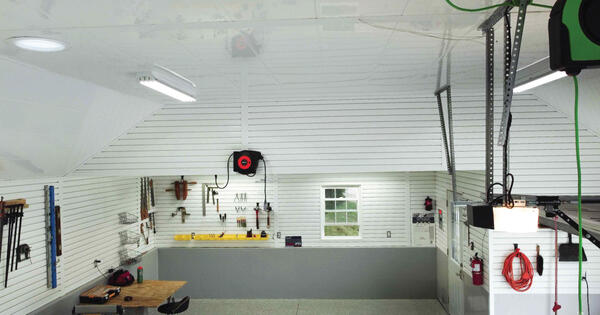This post was originally published in March 2023. Last updated: April 2025.
Drywall has long been the go-to material for ceilings, but it’s not always the best choice — especially for homeowners tackling DIY projects. Whether you’re renovating a basement, updating a garage, or looking for a ceiling material that’s easier to install, there are plenty of alternatives that offer unique benefits.
Choosing a different ceiling material can save time and effort, improve durability, and even enhance the aesthetics of a space. Some options require less labor, making them ideal for DIYers, while others resist moisture better than drywall — perfect for humid areas like bathrooms and basements. Exploring alternatives can also open up new design possibilities, helping homeowners achieve a unique or more polished look without the hassle of taping, mudding, and sanding drywall.
Why Choose a Drywall Alternative for Your Ceiling?
While drywall is common, it comes with its fair share of challenges — especially when it’s installed on a ceiling. It’s heavy, difficult to handle alone, and requires precise taping and finishing to achieve a smooth surface. Even when properly installed, drywall is prone to cracks over time, particularly in homes that experience shifts in temperature and humidity.
Beyond installation challenges, drywall isn’t the most durable option. It’s susceptible to water damage, which can lead to sagging, mold growth, or unsightly stains — problems that often require costly repairs. If you’re finishing a basement, garage, or bathroom, finding a moisture-resistant alternative can help avoid long-term maintenance headaches.
Fortunately, there are plenty of ceiling materials that are easier to install, more durable, or even more cost-effective than drywall. Some options come in interlocking panels that snap together, eliminating the need for joint compound. Others provide a decorative touch without requiring extensive finishing work. No matter your project, there’s an alternative that can make the job simpler while still delivering a polished result.
Key Considerations When Selecting a Ceiling Material
Before deciding on a drywall alternative, it’s important to consider factors like installation difficulty, cost, durability, and maintenance. Some materials are lightweight and easy to install — perfect for a weekend DIY project — while others require additional support structures or specialized tools.
Here’s how different ceiling materials compare:
- Ease of Installation: Some options, like tongue-and-groove planks and PVC panels, snap or interlock into place, making them DIY-friendly. Others, like metal panels or beadboard, require careful alignment but are still more manageable than drywall.
- Cost: Budget-friendly options like plywood or beadboard offer a simple upgrade without breaking the bank. Higher-end choices, such as metal ceiling tiles, cost more but provide a striking aesthetic.
- Durability: In high-moisture areas, materials like PVC, vinyl, and metal perform better than drywall, resisting water damage and mold growth. Wood and MDF alternatives may require sealing to prevent warping.
- Maintenance: Smooth surfaces like PVC panels and metal tiles are easy to clean, while textured or porous materials — such as beadboard or wood planks — may require occasional refinishing or sealing.
If you’re working on a space prone to humidity, like a basement or bathroom, moisture-resistant materials are key. PVC ceiling panels, vinyl planks, and metal tiles hold up well in damp environments, preventing issues like swelling, warping, or mold growth.
For homeowners focused on aesthetics, the right ceiling material can add character and style to a space. Wood planks and beadboard create a warm, inviting look, while shiplap or tin ceiling tiles offer a more distinctive design. Many materials come pre-finished or can be painted, allowing for complete customization.


Top DIY Ceiling Alternatives to Drywall
If you’re looking for an alternative to drywall for your ceiling, you’ve got plenty of great options — each with its own benefits and ideal applications. Whether you want a simple, cost-effective solution or a stylish upgrade, the right material depends on your space, budget, and skill level.
1. PVC Ceiling Panels
PVC panels are a durable, waterproof alternative to drywall that’s perfect for areas with high moisture levels like bathrooms, basements, laundry rooms, and garages.
- Pros: 100% waterproof, lightweight, resistant to mold and mildew, and easy to install.
- Cons: Can be more expensive than budget-friendly options like plywood or beadboard.
2. Plywood Panels
Plywood is a budget-friendly and easy-to-install ceiling material that works well in a variety of spaces, including garages, workshops, and rustic-style interiors. It comes in large sheets, making it quick to cover a ceiling with minimal seams.
- Pros: Affordable, easy to install, lightweight, and can be painted or stained for a finished look.
- Cons: Can warp in humid environments, may require additional finishing for a polished appearance.
3. Beadboard or Shiplap
Beadboard and shiplap are classic wood paneling options that add charm and texture to a ceiling. Beadboard has narrow, vertical grooves, while shiplap consists of overlapping planks for a farmhouse look. It’s a good choice for kitchens, bathrooms, and living spaces where aesthetics matter.
- Pros: Visually appealing, easy to paint, and adds character to a room.
- Cons: Can be labor-intensive to install, requires sealing in humid areas to prevent warping.
4. Tongue-and-Groove Planks
These interlocking wood planks create a seamless, elegant ceiling with a natural or stained finish in living rooms, bedrooms, and finished basements. The tongue-and-groove design makes installation easier than standard planks.
- Pros: Creates a high-end look, hides seams well, and is relatively easy to install.
- Cons: Can be more expensive than other options, may need sealing in moisture-prone areas.
5. Metal Ceiling Tiles
Metal tiles, often made from tin, aluminum, or steel, add an eye-catching, decorative touch to a ceiling. They’re available in embossed designs and can be painted or left as-is and are often best suited to dining rooms, kitchens, and vintage-inspired spaces.
- Pros: Highly durable, moisture-resistant, and adds a unique aesthetic.
- Cons: Higher cost, installation requires precise alignment and possibly additional support.
6. Drop Ceiling (Suspended Ceiling Tiles)
A drop ceiling consists of a grid system that holds lightweight tiles in place. While often used in commercial spaces, it’s also a great option for hiding ductwork or electrical wiring in basements, home offices, and rooms with exposed utilities.
- Pros: Allows easy access to utilities, helps with soundproofing, and comes in various designs.
- Cons: Requires space for the grid system, can look outdated if not chosen carefully.
7. Fabric or Stretched Ceilings
A fabric ceiling involves stretching a lightweight fabric across the ceiling, creating a soft, modern look. Some high-end versions use PVC-based stretch membranes for a more structured finish. It’s an ideal solution for bedrooms, media rooms, and contemporary spaces.
- Pros: Unique aesthetic, hides imperfections, and can be easily changed.
- Cons: Not as durable as other options, can collect dust or sag over time.
Trusscore Wall&CeilingBoard: A Superior DIY Drywall Ceiling Alternative
For homeowners looking for a hassle-free, durable ceiling solution, Trusscore Wall&CeilingBoard offers a superior alternative to drywall for several reasons, including:
- They’re lightweight and easy to install. An eight-foot length Trusscore Wall&CeilingBoard panel weighs less than eight pounds, which is 40% less than drywall. Pre-finished panels also come with a pre-punched screw flange and a tongue and groove interlocking system, making installation a breeze for DIYers and contractors alike. Equipped with a set of basic tools, you can plan to have Trusscore Wall&CeilingBoard installed in a single afternoon — no painting required.
- They’re moisture and water resistant. Made from PVC, Trusscore Wall&CeilingBoard panels are 100% water and moisture resistant — they shed water and install in a way that creates a water-resistant barrier. Unlike drywall, the panels won’t absorb airborne moisture, won’t degrade or deteriorate in wet or damp environments, and will never grow mold or mildew.
- They’re strong and durable. Trusscore ceiling panels are scratch, dent, and damage resistant and are designed to outlive the buildings they're installed in. Combined with a unique internal truss design, you can be confident that Trusscore Wall&CeilingBoard will stand the test of time.
- They’re bright and reflective. Trusscore Wall&CeilingBoard comes in a bright white finish that reflects 90% of the light that strikes the panels. On the ceiling, these reflective panels will maximize any fixture or natural light in the space and help smaller, darker rooms like garages appear larger and brighter.
- They’re available in a variety of lengths. On long, stretching ceilings, you’ll likely have to lift several 4’ x 8’ sheets of drywall over your head to install them. Trusscore Wall&CeilingBoard panels come in 8’, 10’, 12’, 14’, 16’, and 20’ lengths, making them the perfect choice for oversized structures (like pole barns and barndominiums).
- They can be removed and replaced. Unlike drywall, Trusscore Wall&CeilingBoard panels can be removed and put back in place if you ever to gain access to wires or plumbing above the ceiling. With drywall, access is achieved only by cutting into the drywall, then patching afterward. More tape. More mud. More sanding. More paint.
Whether you’re upgrading a basement, finishing a garage, or looking for a durable ceiling material that won’t require ongoing maintenance, Trusscore Wall&CeilingBoard is a smart investment that saves time and effort.



Which DIY Ceiling Alternative Is Right for You?
With so many ceiling alternatives available, choosing the right one comes down to a balance of cost, durability, and aesthetics.
- For budget-conscious DIYers: Plywood and beadboard are cost-effective options that offer a finished look without breaking the bank.
- For moisture-prone spaces: PVC panels, Trusscore Wall&CeilingBoard, and metal tiles resist water damage, making them ideal for bathrooms, basements, and garages.
- For easy installation: Trusscore panels, drop ceilings, and tongue-and-groove planks provide straightforward installation with minimal finishing work.
- For a decorative touch: Beadboard, shiplap, metal tiles, and stretch ceilings enhance a room’s style while covering imperfections.
Ultimately, the best choice depends on the specific needs of your space. If you want a low-maintenance, long-lasting solution that installs quickly, Trusscore Wall&CeilingBoard is a standout option. For those focused on aesthetics, beadboard, shiplap, or metal ceiling tiles can add personality to a room. No matter your budget or skill level, there’s a drywall alternative that’ll fit your project perfectly.
Upgrading your ceiling doesn’t have to be complicated — choosing the right material is the best first step. Start by considering your space, budget, and skill level. Do you need something moisture-resistant for a basement or bathroom? Are you looking for a quick and easy DIY option? Or is style your top priority? Once you know what you need, you can narrow down the best drywall alternative for your home.
Most ceiling materials, from plywood and beadboard to PVC panels like Trusscore Wall&CeilingBoard, are available at home improvement stores and online retailers. Many brands provide installation guides, video tutorials, and step-by-step instructions to help DIYers complete the job with confidence. If you’re tackling a ceiling upgrade for the first time, checking out manufacturer resources or home improvement websites is a great way to ensure a smooth installation process.
No matter which alternative you choose, replacing a drywall ceiling can enhance your space while making future maintenance easier. With the right materials and a little planning, you can transform your ceiling into a durable, stylish feature that fits your home perfectly.






